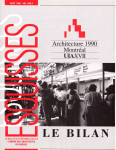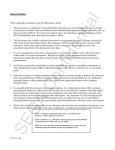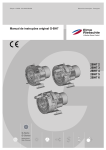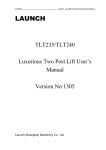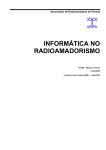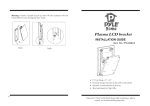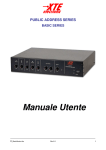Download THE R-390 COOKBOOK BY A. CARMODY, w2LE/AAR2Q,R
Transcript
THE R-390 COOKBOOK BY A. CARMODY, w 2LE/AAR2Q,R The R—390 COOKBOOK was intended to be used in conjunction with the R-390/URR Service Manual. However, sufficient information is provided so that each modification can be accomplished without the aid of the Service Manual. These modifications have been incorporated into several receivers with excellent results. The Author, however, assumes no responsibility for the operation of these circuits. A. Carmody September, 1983 (C) Copywrite, 1983, Empty Cloud, Canandaigua, N.Y. All rights reserved CONTENTS I TEM PAGE POWER SUPPLY SUB-CHASSIS MODIFICATION 1-2 IF SUB-CHASSIS MODIFICATION 3-Li. AF SUB-CHASSIS MODIFICATION LOW IMPEDANCE SPEAKER CONNECTION 7 ANTENNA IN PUT CONVERSION TO ~O OHMS 8-9 UNITED STATES ARMY MARS MILITARY AFFILIATE RADIO SYSTEM A.J. CARMODY, AAR2Q.R/W2LE MODULE POWER SUPPLY SUB-OHS REV A ~ REF PAGE ( S) 1 REMARKS ‘9 ~, 96 PURPOSE: To convert the power supply from vacuum tubes (26Z~W) to solid state diodes. REASON: 1) Replacement tubes hard to find. 2) Eliminate heat from vacuum tube rectifiers. 3) Improve reliability with solid state diodes. TOOLS REQUIRED: 1) Long phillips head screwdriver 2) Soldering iron and solder 3) Diagonal cutters L~) Long nose pliers PARTS REQUIRED: Two (2) 1NLi.007 diodes, 1000 PIV, 1 amp or equivalent. PROCEDURE: 1) Disconnect main power to the receiver. 2) Remove tube shields and 26Z54 vacuum tubes from the power supply. 3) Disconnect the power plug to the POWER SUPPLY SUB-CHASSIS. L~) Using the phillips screwdriver, remove the four (L1.) screws that hold the transformer to the side panel of the MAIN CHASSIS. NOTE In the next two steps you will loosen three (3) captive screws which hold the power supply to the chassis. ~) Locate 6) 7) the GREEN phillips head screw adjacent to the tube socket and loosen it completely. There are two (2) locating holes in the top of the POWER SUPPLY SUB-CHASSIS bracket. Below each hole is a GREEN phillips head screws Loosen both of these screws completely. Grasp the POWER SUPPLY SUB~CHASSIS and remove it from the receiver. (1) UNITED STATES ARMY MARS MILITARY AFFILIATE RADIO SYSTEM A.J. MODULE ~POWER~BUPPLY ~SUB-CHS T REV A CARMODY, AAR2~R/W2LE 1 REF PAGE (S) 9~, 96 REMARKS I, 8) Place the POWER SUPPLY SUB—CHASSIS on a bench with the bottom of the tube sockets facing you. NOTE: When installing their polarity. diodes, it is important See Fig. 1. to observe 9) Install a diode on socket XV80]., the cathode lead (banded end) soldered to Pin 3. 10) Solder the anode lead to XV8O1 Pin 6. 11) Install a diode on socket XV802, the cathode lead (banded end) soldered to Pin 3. 12) Solder the anode lead to XV802 Pin 6. THIS COMPLETES MODIFICATION OF THE POWER SUPPLY SUB-CHASSIS ANODE LEAD EI~T~1ODE FIG. I (2) LEAD UNITED STATES ARMY MARS MILITARY AFFILIATE RADIO SYSTEM A.J. CARMODY, AAR2QR/W2LE MODULE IF SUB-CHASSIS REV A REF PAGES 199,128,129 REMARKS 1 - PURPOSE: To replace ballast tube 3TF7 with a conventional vacuum tube. REASON: 1) Ballast tubes are hard to find and expensive. 2) Other methods using power dropping resistors dissipate excessive beat under the chassis which is undesirable. 3) Use of voltage regulators require more parts and are more costly. Li.) This method allows easy substitution of ballast tubes.... if you are lucky enough to find them. TOOLS REQUIRED: Wire strippers Set of Allen wrenches Phillips head screwdriver Soldering iron and solder Assortment of multi-colored fiber-tipped marking pens. PARTS REQUIRED: Three (3) inches #22 AWG PVC insulated hook-up wire One (1) 1 2BH7 or 1 2BY7 vacuum tube PROCEDURE: 1) Disconnect main power to the receiver. NOTE In the following step the IF SUB-CHASSIS to loosening the shafts, of the BANDWIDTH knob 2) Using an Allen Oldham coupler panel controls 3) Disconnect the -- - you will loosen two (2) shafts from the controls on the front panel. Before it is important to note the position and the BFO PITCH knob. wrench, loosen the set screw on each which secures each shaft from the front to the IF SUB—CHASSIS. power plug to the IF SUB—CHASSIS. (3) UNITED STATES ARMY MARS MILITARY AFFILIATE RADIO SYSTEM A.J. CARMODY, AAR2QR/W2LE MODULE IF SUB—CHASSIS 1 REV A 1 REF PAGE (5) 99,128, 129 REMARKS ~ - NOTE In the next step you will disconnect two (2) BNC connectors. It is important to identify the cables and connectors. I use colored marking pens. Other methods such as tages, tape are OK just as long as you know where the cables go. Ii.) Mark or somehow identify the BNC chassis connectors and the cables attached to them. ~) Disconnect the cables from the BNC chassis connectors. 6) Locate the GREEN phillips head screws on top of the IF SUB—CHASSIS and loosen them completely. 7) Grasp the IF SUB-CHASSIS and carefully remove it from the chassis. Try not to disturb the position of the protruding shafts. 8) Locate the ballast tube 3TF7 and remove it from it’s socket. 9) Place the IF SUB—CHASSIS on a bench with the bottom of the tube sockets facing you. 10) Prepare two (2) lengths of hook-up wire. Each wire cut to one (1) inch. 11) Strip ¼ inch of insulation from each end of each wire. 12) Locate the ballast tube socket XRT ~l2. 13) Solder one of the jumper wires from Pin 2 to Pin L. on socket XRT ~l2. Be careful not to disturb existing wiring. lLi.) Solder the remaining jumper wire from Pin 7 to Pin ~ on socket XRT S12. 1~) Install either a 12BY7 or 125117 vacuum tube and tube shield in socket XRT ~l2, THIS COMPLETES MODIFICATION OF THE IF SUB-CHASSIS (1$.) UNITED STATES ARMY MARS MILITARY AFFILIATE RADIO SYSTEM A • J • CARMODY, AAR2Q.R/W2LE MODULE AF SUB-CHASSIS REV I REF PAGE (S) 197,98.99.131 A REMARKS 1 - PURPOSE: To replace the 6082 (2L~. volt f 11) regulator tubes which are expensive and hard to find with 6o8o (6 volt f 1].) tubes. NOTE: 6AS7G tubes are electrically similiar to the 6o8o but are too large to fit Into the R-390. TOOLS REQUIRED: Phillips head screwdriver Soldering iron and solder Wire strippers Diagonal cutters Nut driver set or small socket set PARTS REQUIRED: Power diode, stud mounted with mounting hardware lNll83, 3~amp, ~0 Ply or equivalent. Three feet #20 AWG or larger PVC insulated hook—up wire, Thermal heat sink compound — available at Radio Shack stores. ---NOTE--The original filament circuit of the two (2) regulator tubes V6O~and V6o6 is wired in parallel. In this modification, the filament circuit will be connected in series as indicated in Fig, 1. Polarity of the diode doesn’t matter. Just be sure the mounting stud is securily fastened to the sub—chassis for heat-sinking purposes, PROCEDURE: 1) Disconnect main power to the receiver. 2) Locate the two regulator t~.ibes V6O~and v6o6 on the AF sub—chassis, 3) Remove the holding rings and the regulator tubes from their sockets, Li.) Disconnect the two (2) power plugs from the AF sub-chassis. ~) Locate the GREEN phillips head captive screws. Loosen them completely. 6) Grasp the AF sub-chassis, gently removing the unit from. the chassis. 24VAC V605 V606 8f”~7 7 t’,~ rI~,. (S) UNITED STATES ARMY MARS MILITARY AFFILIATE RADIO SYSTEM A,J. CARMODY, AAR2Q,R/W2LE MODULE AF SUB-CHASSIS REV A J REF PAGE (5) 97,98,99,131 1 REMARKS - 7) Set the AF subohassis on a bench with the bottom of the tube sockets facing you. NOTE: There are several large holes in the chassis around the base of the octal tube sockets to provide air circulation. We will use one of these holes to mount the stud diode. 8) Mount the stud diode in one of the chassis holes. Select a hole between the octal tube sockets, If the hole is larger than the stud, use flat washers from your junk box. Be sure to coat the flat base of the stud diode with heat-sink compound. Also apply a thin coat of compound to the flat washers, 9) Wire the circuit, ref ering to Fig. 2A and 25. V606 V605 ORIGINAL FIG2A V606 \ V605 MODIFIED \BLK FIG2B (6) \ \BLK unsaw ae~,~a ~ MARS MIUTARY AFFILIATE RADIO SYSTEM A.J. CARMODY, AAR2QR/W2LE MODULE NONE REV I - -- REF PAGE (S) 1.2O.81.82,8~ 1 REMARKS LOW IMPEDANCE SPKR CONNECTI~Q~N The R-390 receiver has two (2) audio channels, LOCAL AUDIO and LINE AUDIO with seperate gain controls for each channel. The output impedance of each channel is 600 ohms. The LINE AUDIO channel is intended to be used as a balanced audio line. The LOCAL AUDIO channel is to be used for speaker and headphones. The R-390 receiver does not have a self-contained speaker. Therefore, it Is necessary to provide an external speaker. Most speaker impedances are low, typically 14. to 16 ohms. Since the LOCAL AUDIO output ix~edance of the receiver is ~OO ohms, if we wish to connect a low impedance speaker to the receiver, an audio impedance matching transformer must be used. A filament transformer from the junk box will work but has poor high frequency response. Radio Shack (TM) stores offer a 70V Line Transformer stock number 32-1031 for under $~.OOwhich works very well. It’s secondary is tapped for 14.18/16 ohms and has solder lug terminals. Connect the high impedance primary of the transformer to TB2—6 and TB2-7 located on the rear panel of the receiver. Refer to Fig. 1 for proper connections. Di~Il~1) REAR PANEL OF R-390 RECEIVER SPKR XFMR (7) WUIW ~IAl~~ A~I MARS MIUTARY AFFILIATE RADIO SYSTEM A • J • CARMODY, AAR 2QR/W 2LE MODULE REV REF PAGE (S) I REMARKS I NONE I20,.i.7ati.8 INPUT connectors CONV TO 50 OHMS PURPOSE: To replace antenna input connectors ANTENNA with S0-239 that mate with standard ham equipment. Change antenna input from a balanced line to an unbalanced line. REASON: Adapters or “C” type connectors are difficult to locate and are non-standard ham equipment. Most ham stations use ~0 ohm unbalanced coaxial line. TOOLS REQUIRED: 1) Phillips head screwdriver 2) Colored marking pens 3) Soldering iron arid solder Li.) Long nose pliers ~) Wire strippers 6) #6—32 tap PARTS REQUIRED: 1) Two (2) 50—239 coax sockets 2) Eight (8) #6-32 pan head screws 3) One (1) foot of hook-up wire PROCEDURE: 1) Disconnect main power to the receiver 2) Place the receiver on a bench with the top removed and the rear panel facing you. NOTE In the .next step you will remove the module containing the antenna connectors, It is important to clearly mark the BNC connectors J109, Jib, Jlll with tape or colored marking pens before removing the cables from the module. 3) Li.) Locate the three (3) BNC connectors Jb09, JllO and Jlll on the module, Using a different color pen or tape, mark each BNC connector and it’s associated cable. (8) W~SIW~$AI~ MARS MIUTARY AFFILIATE RADIO SYSTEM A,J. CARMODY, AAR2~R/W2LE MODULE - NONE - REV I - - ~) Disconnect the REF PAGE(5) 1 I.2b.b. 7.ti.8 three (3) cables REMARKS ANTENNA INPUT CONV TO 50 OHMS from the BNC connectors. 6) Locate the three (3) screws that hold the antenna module to the rear panel. Remove and save the screws, remove from the rear panel. 6) Remove and save the two (2) screws that hold the cover on 7) The module should now be free to the antenna module, 9) Solder a small jumper wire from the center of JilO to ground. NOTE In the next step you will remove the BREAK-IN RELAY and it’s associated hardware, This feature has no effect on the performance of the receiver. 10) Remove the two insulated wires going to the relay coil and tape the ends of the wires, 11) Remove the relay from the antenna module. 12) Unsolder all wires going to the antenna connectors 3107,3108. 13) Using a screwdriver, remove both antenna connectors Jb07,J108. ‘J~.) Remove ~ny wires ~ing to the center of 3109 and Jill. NOTE In the next step you will put threads in the four mounting holes of each SO-239 connectors, l~) Locate the S0-239 antenna connectors and thread the four (14.) mounting holes of each connector using the #6-32 tap. 16) Install one of the S0—239 connectors at J107 (UNBALANCED WHIP) such that the connector is inside the antenna module, 17) Solder a small piece of hook—up wire from the center of J107 to the center of Jl09, 18) Similiar to STEP 16, install the remaining SO—239 connector at 3108, 19) Solder a small piece of hook-up wire from the center of Jio8 to the center of Jill. 20) Replace the cover on the antenna module. 21) Install the antenna module in the receiver. 22) Reconnect the three (3) cables to the BNC connectors, I’ve found it ó~iivenient to connect a second receiver’s antenna input to 3107 using a short cable and connect my main antenna to 3108 so that the two receivers share the same antenna. (9) TESTING R—390( )/uRR RECEIVERS DESCRIPTION OF TEST: 1. APPLY ONE MICROVOLT CV) TEST SIGNAL TO RECEIVER INPUT. 2. TUNE RECEIVER FOR ZERO—BEAT BETWEEN TEST SIGNAL AND SF0 AT CENTER OF 2KC IF BANDPASS. 3. ADJUST RECEIVER GAIN FOR AN AUDIO OUTPUT OF PLUS 10DB OR OTHER CONVENIENT LEVER, (SIGNAL PLUS RCVR NOISE). ~-I. DE—TUNE RECEIVEE~FROM TEST SIGNAL AND MEASURE RECEIVER NOISE. 5. A DIFFERENCE OF 20DB BETWEEN SIGNAL PLUS RECEIVER NOISE AND RECEIVER NOISE INDICATES A GOOD R—390 RECEIVER. - STANDARD SIGNAL C-ENERATOR AN/URM—25 RECE I.VER R-390( )/uRR TEST SIGNAL OUTPUT 10 MICROVOLTS LOCAL AUDIO OUTPUT MET ER TS-5~5/U F Ltc~uL~ ~330OHM COAX CA BL E Z=50 OHM 56 ~2 ~Z=7O OHM ~M OH~: CU—~40~/URM—25F IMPEDANCE MATCHING NETWORD AND 10:1 VOLTAGE DIVIDER) NOTE: CU—~0~/URM—25FIS SUPPLIED W/URM—25F MODEL ONLY. FOR URM-25D AND OTHER MODELS CHANGE RESISTORS AND CIRCUIT IN EITHER 5;1 OR 10:1 ATTENTUATORS TO AGREE w/Cu—1+o~ CIRCUiT AS SHOWN ABOVE. PROCEDURE: 1. SET A. B. C. •D. RECEiVER CONTROLS FORCW RECEPTION: BANDWIDTH——2KC AUDIO RESPONSE-—WIDE BFO PITCH——ZERO LIMiTER--OFF T~7 2. 3. k. 5. 6. 7. E. FUNCTION-—MGC F. RF GAIN——MAX TUNE RECEIVER TO ZERO BEAT WITH TEST SIGNAL. TURN BFO PITCH TO MINUS 1 OR PLUS 1. PEAK ANTENNA TRIMMER FOR MAXIMUM INDICATION ON TS-5~5. Dc~ ________________ ADJUST RF GAIN FOR PLUS ~ DE—TUNE RECEIVER AT LEAST 1OKC FROM TEST SIGNAL FREQUENCY. TS—5~5NOW INDiCATES RECEIVER NOISE OUTPUT RESULTING FROM STANDARD GAIN SETTING ESTABLISHED BY STEP FIVE ABOVE. RECEIVER PASSES TEST IF NOISE iNDICATION ON TS—5~5 IS M.!NUS 10DB CR LESS. TEST FREQUENCIES: 1.5MC; (1—2 MC BAND) 3.OMC; ..(2_1~.MC BAND) 14—~ IviC BAND) 6.oMC,~((~—i6 12.OMC, MC BAND) 2~-i..OMC, (16-32 MC BAND) 2 p~7














